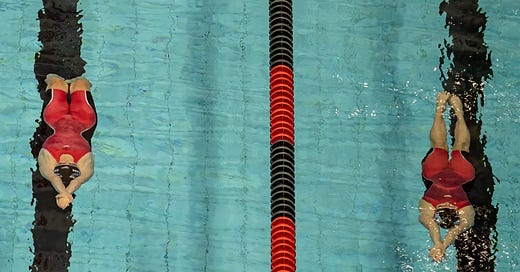By Wayne Goldsmith
Three Key Concepts
Every moment in practice presents a choice between minimum and maximum standards
Success belongs to swimmers who choose to take ownership of their preparation
Coaches must teach swimmers to make better choices, not just follow instructions
PHOTO - THE AMAZING AND GOOD FRIEND - PETER BICK
Two swimmers, same age, same ability, same coach, same workout. One becomes a champion, the other quits the sport. What's the difference?
The difference isn't talent, technique, or training equipment. It's the power of choice.
I've seen this scenario play out thousands of times across three decades of coaching. Two swimmers approach the wall during practice. The workout calls for 20 x 50 freestyle on 1:30. Both swimmers understand the set, both can make the time, both know what good technique looks like.
Swimmer A pushes off with a loose streamline, breathes on the first stroke, kicks lazily underwater, and finishes with their head up. They make the time. They complete the set. They follow instructions.
Swimmer B explodes off the wall in perfect streamline, kicks powerfully underwater, doesn't breathe for five strokes, maintains perfect rhythm, and attacks every wall. Same time, same distance, same set.
The difference? Choice. One swimmer chose to do the minimum standard required. The other chose to do the maximum standard possible.
Here's what coaches need to understand: you can't motivate choice—you can only teach it. Stop telling swimmers what to do and start teaching them why their choices matter. Every push-off, every breath, every turn is an opportunity to choose excellence or mediocrity.
The power of choice transforms followers into leaders, squad swimmers into champions. It's free, it's forever, and it's the only equipment that never breaks or wears out.
Summary: The power of choice—deciding to do maximum standards instead of minimum requirements—is the ultimate difference between good swimmers and great ones.
Three Practical Exercises
Choice Awareness Drill: During every set, ask swimmers to identify three specific choices they made (streamline tightness, breathing control, wall attack) and rate them 1-10.
Maximum Standard Challenge: Write two versions of every skill on the board—minimum standard vs. maximum standard—and challenge swimmers to choose which swimmer they want to be.
Ownership Conversations: After each practice, ask swimmers "What choices did you make today that will make you faster tomorrow?" Make them the authors of their own success story.
Copyright Wayne Goldsmith. All Rights Reserved.





